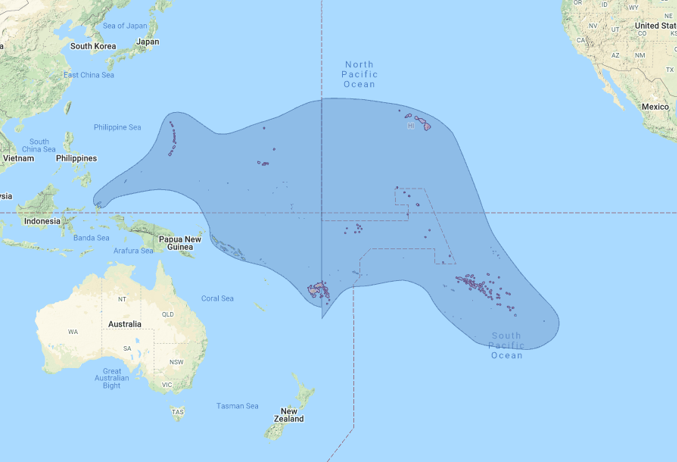Birdfinding.info ⇒ Uncommon across most of its extensive range, but locally common around many of its remote nesting islands, including Kiritimati, Tahiti, and the Marquesas. The most accessible place where it has be seen consistently (but not frequently) is on Oahu’s Ka Iwi Coast from the Lanai Lookout to Makapu’u Point, especially in late afternoon from March to May. The colony on Moku Manu is visible with a scope from Marine Corps Base Hawaii, where access is restricted.
Gray-backed Tern
Onychoprion lunatus
Breeds in Micronesia, Hawaii, and Polynesia, and disperses across the tropical Pacific.
Breeding. Nests from February to October on remote atolls and islets.
In Micronesia, on the northern Marianas, Wake, Johnston, and northern Marshall Islands.
In Hawaii, the largest colonies are on Lisianski (~17,500 pairs), Nihoa (~10,000), Laysan (~7,500), Necker (~4,000), and Gardner Pinnacles (~2,000—the only colony where it outnumbers Sooty Tern). Smaller numbers nest on Midway (~1,000), French Frigate Shoals (~1,000), Pearl and Hermes Reefs (~700), Kaula (~500), Kure (~25), and east of Oahu on Moku Manu (~25).
In Polynesia, on the Phoenix, Line, Society, Tuamotu, and Marquesas Archipelagos.
Nonbreeding. Partly sedentary around nesting islands, but some portion of the population disperses from October through February to more distant seas southwest to Palau, the Solomon Islands, south to Fiji and Samoa, east to Clipperton Island, and southeast to the Tubuais, Pitcairns, Easter Island, and Salas y Gómez.
Identification
A mostly pelagic, dark-backed tern that habitually rests on flotsam at sea, much like the closely related and more familiar Bridled Tern.
Breeding adults are medium-gray above, all-white below, with a black cap, white forehead and thin white eyebrows—in the shape of a narrow visor. The upperparts are fairly uniform, but somewhat paler gray on the upper back, which contrasts sharply with the border of its black cap.

Gray-backed Tern. (Eastern Island, Midway Atoll National Wildlife Refuge, Hawaii; March 31, 2018.) © Jonathan Plissner
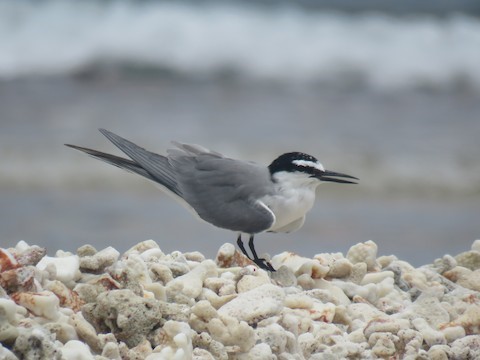
Gray-backed Tern. (Fakarava, Gambier Islands, French Polynesia; November 16, 2019.) © Ron Batie
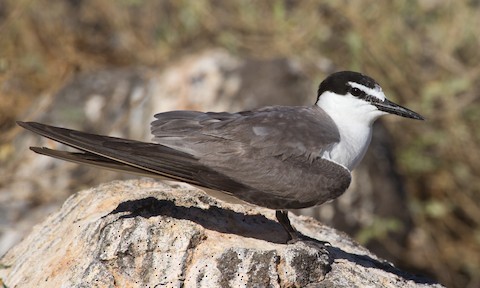
Gray-backed Tern. (Nihoa Island, Hawaii; September 8, 2011.) © Eric VanderWerf
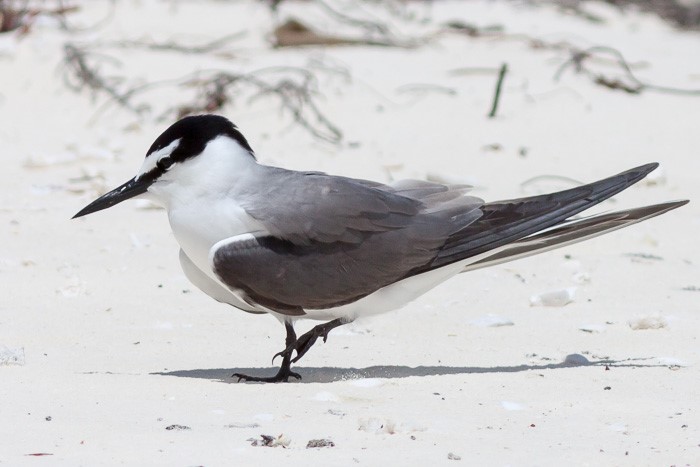
Gray-backed Tern. (Tetiaroa, French Polynesia; September 22, 2013.) © David Sargeant
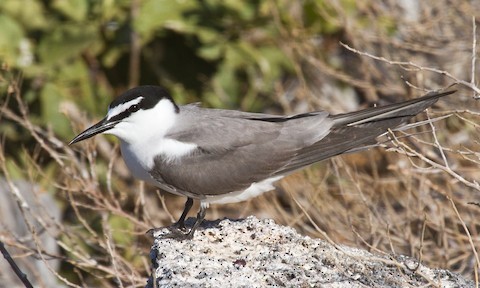
Gray-backed Tern. (Nihoa Island, Hawaii; September 8, 2011.) © Eric VanderWerf

Gray-backed Tern. (Laysan Island, Hawaii; January 14, 2012.) © Cameron Rutt

Gray-backed Tern. (Tetiaroa, French Polynesia; September 22, 2013.) © David Sargeant
Nonbreeders generally resemble breeding adults, but usually have a mostly white forehead, neck, and upper back, with a smudged, blackish hindcrown or cowl.
In flight, from below, the wings appear mostly white, with a narrow dark gray or blackish trailing edge.
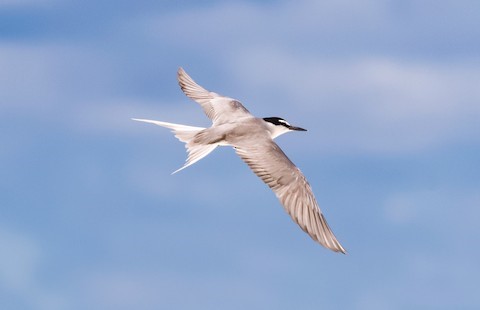
Gray-backed Tern. (Rimatu’u, Tetiaroa, French Polynesia; October 25, 2019.) © Philip Georgakakos

Gray-backed Tern. (Laysan Island, Hawaii; January 14, 2012.) © Cameron Rutt
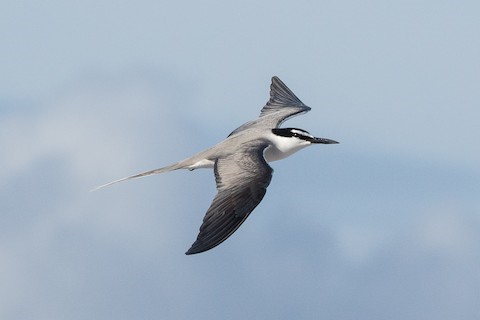
Gray-backed Tern. (Nimroona, Kiritimati, Line Islands, Kiribati; August 15, 2019.) © Eric VanderWerf
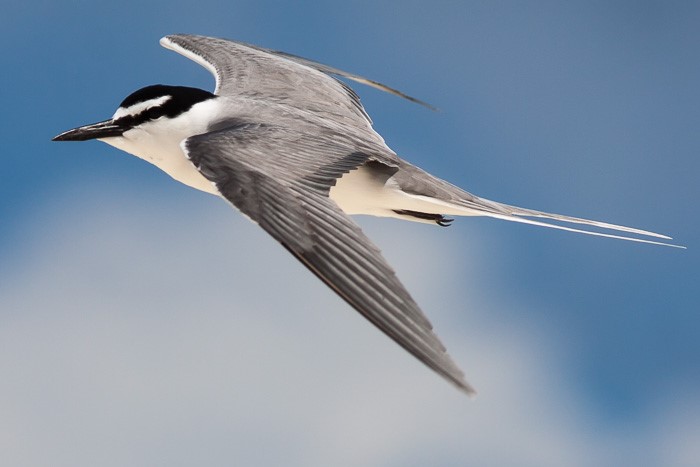
Gray-backed Tern. (Tetiaroa, French Polynesia; September 22, 2013.) © David Sargeant
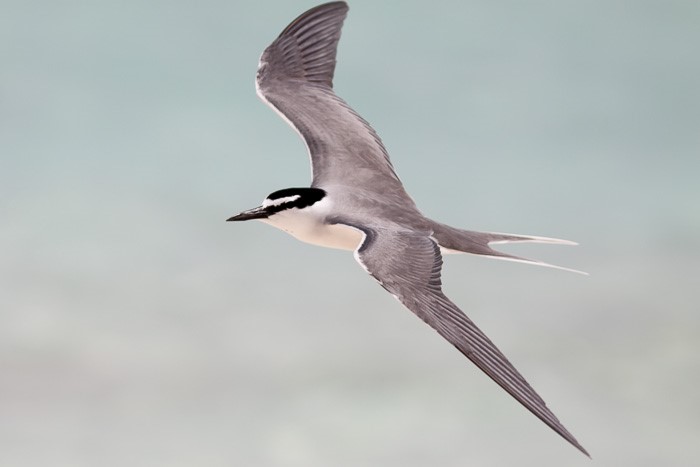
Gray-backed Tern. (Tetiaroa, French Polynesia; September 22, 2013.) © David Sargeant

Gray-backed Tern. (Nihoa Island, Hawaii; September 8, 2011.) © Eric VanderWerf

Gray-backed Tern. (Spit Island, Midway Atoll National Wildlife Refuge, Hawaii; April 17, 2020.) © Will Kennerley
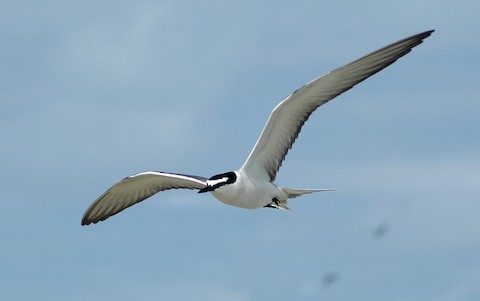
Gray-backed Tern. (Eastern Island, Midway Atoll National Wildlife Refuge, Hawaii; June 2, 2009.) © Steve Tucker
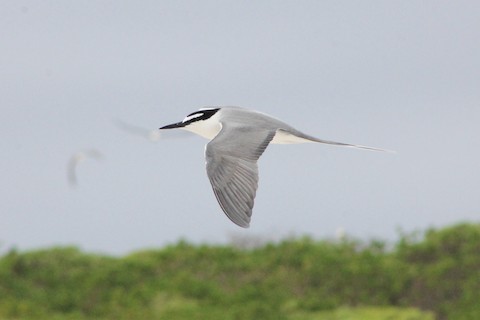
Gray-backed Tern. (Spit Island, Midway Atoll National Wildlife Refuge, Hawaii; April 17, 2020.) © Will Kennerley

Gray-backed Tern, adult and juvenile. (Eastern Island, Midway Atoll National Wildlife Refuge, Hawaii; August 23, 2017.) © Eric VanderWerf
Immature Plumages. Juveniles have roughly the same overall plumage pattern as nonbreeding adults, but with upperparts darker and boldly marked with white or tan fringes.
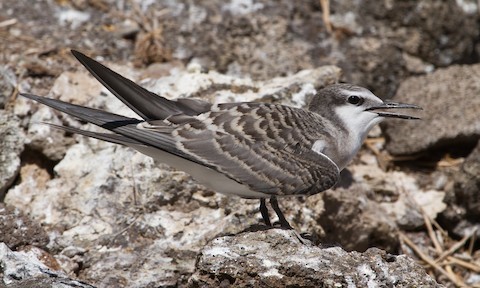
Gray-backed Tern, juvenile. (Nihoa Island, Hawaii; September 8, 2011.) © Eric VanderWerf
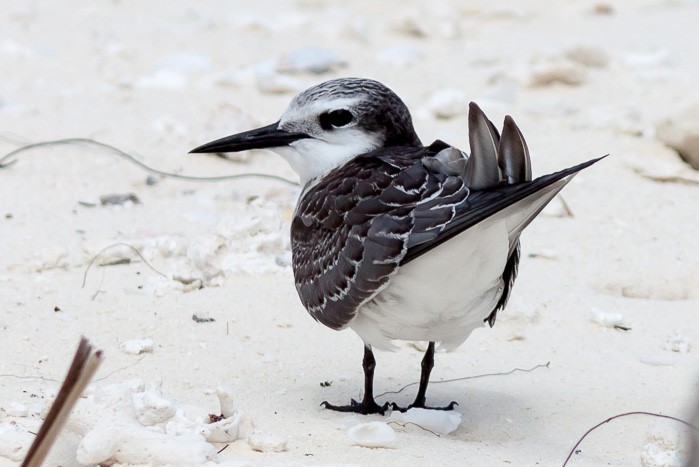
Gray-backed Tern, juvenile. (Tetiaroa, French Polynesia; September 22, 2013.) © David Sargeant

Gray-backed Tern, nestling. (Eastern Island, Midway Atoll National Wildlife Refuge, Hawaii; June 28, 2019.) © Jonathan Plissner

Gray-backed Tern, juvenile. (Nihoa Island, Hawaii; September 8, 2011.) © Eric VanderWerf
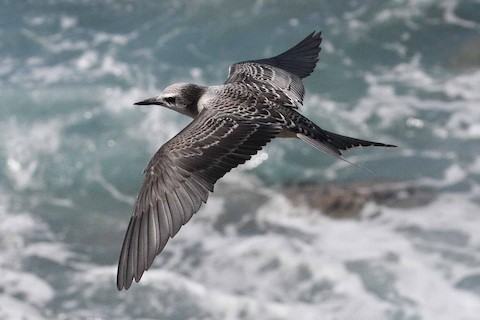
Gray-backed Tern, juvenile. (Moku Manu, Oahu, Hawaii; June 26, 2008.) © Eric VanderWerf

Gray-backed Tern, immature. (Moku Manu, Oahu, Hawaii; May 11, 2010.) © Eric VanderWerf
Voice. Common call is described as “a softer, less harsh version of call of Sooty Tern.” (Pratt et al. 1987)
Cf. Bridled Tern. In the western and central Pacific, Bridled and Gray-backed Terns overlap to some extent and can be indistinguishable under some conditions. On average, Gray-backed has much paler-gray upperparts. The difference in shading is usually conspicuous, but individual variation is sufficient to make some cases ambiguous. In particular, some Bridled Terns are pale enough to be misidentified as Gray-backed. A difference that may still be noticeable in such cases is the presence of a paler collar on Bridled—whereas Gray-backed’s gray upperparts typically appear more uniform in tone (under equivalent lighting, posture, etc.).
A more reliable distinction is the pattern of the underwing: Gray-backed’s is almost entirely white with a narrow dark trailing edge, whereas Bridled is mostly white with a broader dark trailing edge and partly dark primaries (especially the outer ones).
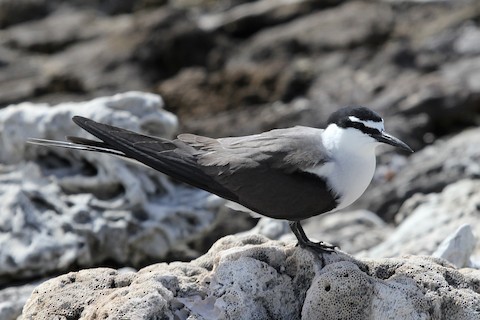
Bridled Tern, O. a. anaethetus. (Leo Island, Houtman Abrolhos Islands, Western Australia; October 14, 2017.) © Ray Turnbull

Gray-backed Tern. (Nihoa Island, Hawaii; September 8, 2011.) © Eric VanderWerf
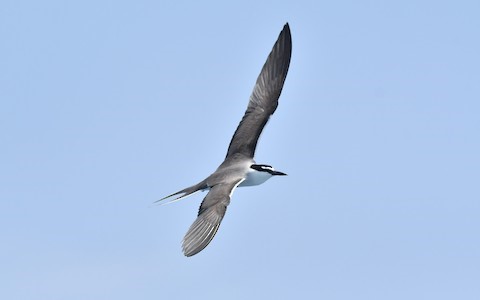
Bridled Tern, O. a. antarcticus. (Offshore from Kochi, Kerala, India; March 25, 2018.) © Aju Raju

Gray-backed Tern. (Laysan Island, Hawaii; January 14, 2012.) © Cameron Rutt
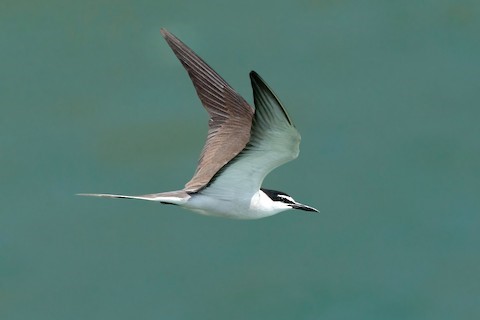
Bridled Tern, O. a. anaethetus. (Xiju Island, Lienchiang County, Taiwan; June 25, 2015.) © David Irving

Gray-backed Tern. (Spit Island, Midway Atoll National Wildlife Refuge, Hawaii; April 17, 2020.) © Will Kennerley
Cf. Aleutian Tern. Gray-backed and Aleutian Terns potentially overlap in the tropical Pacific and could mistaken for one another—especially in breeding plumage as they have similar head patterns and both have medium-gray upperparts. They differ in several respects.
The most reliable distinguishing feature is the shape of the white patch on the forehead. Aleutian’s white patch fully covers the forehead and ends at the eye, whereas Gray-backed has a thin white “visor” with white brow-stripes that extend behind the eye.
On the upperparts, Gray-backed’s back and tail are both gray overall, whereas Aleutian has a contrasting all-white tail. On the underparts, Gray-backed is all-white, whereas Aleutian is pale-gray from the chest to the belly, with a contrasting white throat and white underwings.
Notes
Monotypic species.
Alternatively known as the Spectacled Tern. Some authors note that most terns have gray backs and therefore prefer Spectacled—although the adoption of this name merely exchanges ambiguity for inaccuracy, as lunatus has no markings that approximate spectacles.
References
BirdLife International. 2018. Onychoprion lunatus. The IUCN Red List of Threatened Species 2018: e.T22694722A132569974. https://dx.doi.org/10.2305/IUCN.UK.2018-2.RLTS.T22694722A132569974.en. (Accessed November 29, 2020.)
eBird. 2020. eBird: An online database of bird distribution and abundance. Cornell Lab of Ornithology, Ithaca, N.Y. http://www.ebird.org. (Accessed November 29, 2020.)
Harrison, P. 1983. Seabirds: An Identification Guide. Houghton Mifflin, Boston.
Howell, S.N.G., and K. Zufelt. 2019. Oceanic Birds of the World. Princeton University Press.
Pratt, H.D., P.L. Bruner, and D.G. Berrett. 1987. A Field Guide to the Birds of Hawaii and the Tropical Pacific. Princeton University Press.
Pyle, R.L., and P. Pyle. 2017. The Birds of the Hawaiian Islands: Occurrence, History, Distribution, and Status. Version 2 (January 1, 2017). http://hbs.bishopmuseum.org/birds/rlp-monograph/. B.P. Bishop Museum, Honolulu, Hawaii.
Raine, H., and A.F. Raine. 2020. ABA Field Guide to the Birds of Hawai’i. Scott & Nix, Inc., New York.

